Marinello
In 1922, the United States Federal Trade Commission (FTC) charged the Marinello Company of Wisconsin, the Marinello Company of Chicago, the Marinello School of Chicago and the School of Cosmeticians with anticompetitive practices under Section 3 of the Clayton Antitrust Act (1914), specifically noting the measures the company took to stop price cutting.
The Marinello companies, the Marinello schools and the School of Cosmeticians were closely linked; in one sense they could all be considered to be a part of ‘Marinello’. Francis Chilson – who worked as the company manager of Marinello from 1927 to 1930 after Inecto took control – gives us a summary of the arrangement.
[Marinello’s] products were used in and distributed through more than 5,000 of the largest and most elegant beauty salons in the country. Marinello did not own these salons but controlled them absolutely. Nothing but Marinello products could be used in these salon; no beautician could get a job in any of them unless she had a certificate from a Marinello School of Cosmeticians and this, in turn, was the wholly owned subsidiary of the Marinello Company. It was a closed circuit.
(Chilson, 1972, pp. 59-60)
This advantageous closed business circle was set up by the founder of Marinello, Ruth D. Maurer.
Ruth D. Maurer
Ruth D. Maurer was born in Iowa in 1870 as Ruth Johnson, becoming Ruth Maurer in 1898 when she married the physician and surgeon Dr. Albert A. Maurer [1860-1942] in Kenosha, Wisconsin. Albert Maurer had two sons from a previous marriage, Claude N. Maurer [1887-1963] and Albert A. Maurer Jr. [1891-1964] and the couple did not produce any additional children. After the ceremony they settled in La Crosse, Wisconsin where Dr. Maurer had his medical practice.
Exactly how Ruth Johnson ended up in the beauty business is a bit of a mystery. Published accounts – to which she would have contributed – suggest that her introduction was through writing beauty hints in Chicago newspapers under the name Emily Lloyd, her mother’ maiden name.
Mrs. Maurer first became interested in cosmetics and beauty culture by contributing beauty hints to Chicago papers under the name of “Emily Lloyd.” So numerous were her inquiries regarding creams, lotions etc., that as a natural result she decided to try the manufacture of them according to her own formulas.
(AP&EOR, 1929)
I have been unable to find a single beauty article written by Emily Lloyd in any Chicago newspaper prior to 1903, the year that ‘The Skin. Its Care and Treatment’ was first published – a book widely attributed to her – but it is possible that Maurer worked as a newspaper columnist under another name.
Mme. Michaud
The first edition of ‘The Skin. Its Care and Treatment’ states that it is following the ‘Michaud System’. The Michaud name gets dropped in the second edition of the book which then credits Emily Lloyd as the author. Coincidentally, a Mme. Michaud wrote beauty hints for the Chicago ‘Weekly Inter Ocean’ newspaper, covering many topics in a similar way to those dealt with in the books.
If we accept that Mme. Michaud, Emily Lloyd and Ruth Maurer are one and the same person then the considerable body of information in ‘The Skin. Its Care and Treatment’ can be seen to have derived from a combination of Maurer’s previous writings on the subject combined with technical information provided by McIntosh Battery and Optical Company and advice from other quarters. Athough it seems to have been gathered over a relatively short period of time, Maurer’s knowledge of skin-care appears comprehensive – even extending to cosmetic surgery.
How and why Maurer started writing beauty hints in the first place remains an unanswered question. Given her prodigious output of printed material it would seem that she had both an interest in, and talent for, the written word, and may have started out as a journalist. Newspapers of the time were dominated by male correspondents with women generally regulated to ‘Women’s Interests’ sections, such as social events, fashion and beauty hints, and this may have been reason behind her introduction to Beauty Culture.
The use of a French sounding alias such as Mme. Michaud was a common ploy used by American newspapers to increase a beauty column’s credibility with their readers. It also enabled the newspaper to maintain a column after the original writer had left.
A second unanswered question concerns Maurer’s connection to the McIntosh Battery and Optical Company. It is possible that the company approached the newspaper for a suitable writer and Ruth Maurer was chosen. However, first contact may have been made by Maurer herself. In 1901, she patented a depurator (Patent No. 680,723) and may have approached the McIntosh company to make it given that they were close by in Chicago.
Emily Lloyd
The first connectionI have for Emily Lloyd with Marinello comes with the publication of the second edition of ‘The Skin. Its Care and Treatment’ in 1904. The book went through five editions all told – 1903, 1904, 1907, 1910 and 1914 – all of which were published by the McIntosh Battery and Optical Company. Apart from the first, they were all credited to Emily Lloyd which, as previously mentioned, was her mother’ maiden name.
The book covered a wide variety of topics including: the structure of the skin; the manufacture of skin creams; the use of some cosmetics; how to massage; treatments for skin, hair, nails, feet, hands, teeth and the body; common skin complaints such as blackheads, pimples, freckles and wrinkles; electrical treatments; as well as diet, exercise, weight gain and weight loss and was generally well received by medical journals.
The writer of this somewhat extensive work modestly conceals his name, but the book merits careful reading at the hands of the physician who is pestered by a patient who wants some local treatment for a disfiguring facial blemish, or by individuals who make skin treatment their speciality. In our judgement either a woman has written much of the book or there has been feminine collaboration. It aims at the “open sesame” to beauty, and contains much of interest, even to those of us who believe that we can struggle along without doctoring our faces too much.
(The Detroit Medical Journal, 1903, pp. 239-240)
As might be expected, electrical machinery, manufactured by the McIntosh Battery and Optical Company, featured heavily in treatments and there were also McIntosh company advertisements at the back of each edition. The first and subsequent editions also carried an advertisement for the Marinello Company listed at La Crosse, Wisconsin and 57 Washington Street, Chicago. A separate address at Suite 720, the Western Methodist Book Concern Building, situated at 12-24 West Washington Street, Chicago was included in the second edition for anyone wishing to correspond directly with Emily Lloyd.
Why Ruth Maurer maintained Emily Lloyd as an alias is a puzzle. It may have been to avoid any connection with her husband’s medical practice but there is also the possibility that it was to avoid prejudice, given that the Maurer family was Jewish. Perhaps Ruth thought that an anglicised name had a better chance of producing good sales. Whatever the reason, she continued to publish material under her alias well into the 1920s including: ‘The Marinello Text Book’, first published in 1915; ‘The Prismatic Ray (1910), a book on high frequency treatments; the ‘Marinello Messenger’ (1913-1914), an internal news bulletin for Marinello salons; ‘Milady Beautiful’ a commercial magazine, first published in 1913 as the ‘Cometicians Exchange’ which lists Emily Lloyd as its editor; ‘Emily Lloyd’s Note Book’ (1915); ‘Special Lesson’ (1920) published for the National School of Cosmeticians; and assorted newspaper interviews she gave on the subject of beauty treatments. The Marinello Training School was also founded under the name Emily Lloyd.
Marinello Training School
Following the establishment of the Marinello companies, Ruth Maurer started the Marinello Training School, later known as the Marinello School of Beauty Culture. The generally accepted opinion is that it opened in 1905 but the American College and Private School Directory lists it as starting in 1904 (Meyers, 1909, p. 175). It is possible that classes first began in 1904 but the school was only made a business entity the following year.
Maurer may have based her school on the highly successful Moler schools, founded in Chicago in 1893 by A. B. Moler. Although primarily aimed at barbers, Moler included classes for a number of treatments normally associated with Beauty Culture including facial massage, manicure, chiropody and electrolysis, and he eventually opened Moler Beauty Colleges specifically to train cosmetologists.
Going on a picture of an early class, the Marinello school accepted both male and female students and covered both hairdressing as well as skin treatments. Its credo embraced “Scientific Massage as indicated by the position of the blood vessels and nerves. Use of Batteries and Electric Appliances of all kinds” (Lloyd, 1907).
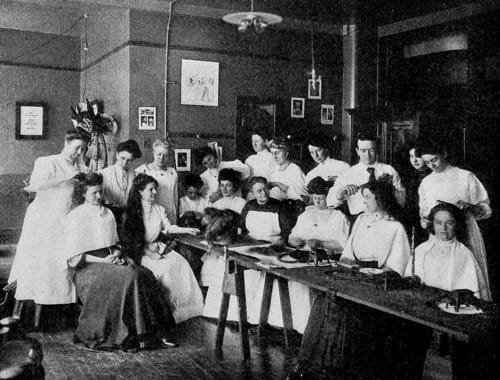
Above: 1907 Hairdressing class at a Marinello School. The Chicago school was based in the Western Methodist Book Concern Building, the same building given for Emily Lloyd.
In the 1907 edition of ‘The Skin. Its Care and Treatment’ Emily Lloyd is listed as the Director of the Marinello Training School and I. R. Outerbridge as its Supervisor of Instruction. It is unlikely that Maurer conducted any of the practical classes – her strengths were more in organisation and publicity – but she could have given occasional talks on the more theoretical sections of the course covered in her books.
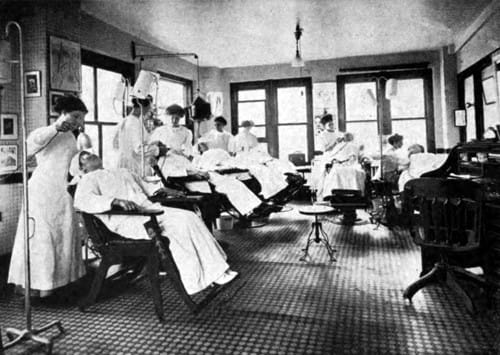
Above: 1910 Class at a Marinello School. The student front left appears to be administering a Red Light Treatment, the one behind a Water Massage (vacuum suction), then a blue light Acne Treatment. At centre back, Faradic Massage and at back right, Electrolysis.
The Marinello schools followed a medical training model. Students were expected to have a basic knowledge of anatomy and the structure of skin, recognise important skin diseases and conditions, and operate in an environment that followed accepted medical standards of disinfection and sterilisation of equipment.
So, no matter who the person is, whether friend, relative or acquaintance, not for one moment should the vigilance be relaxed, but always the same precautions maintained and just as much effort made to avoid infection as though every person treated was a possible source of danger.
Constant, scrupulous effort will inevitably be rewarded. Hence, it behooves every operator to bear in mind always that the one great, imperative, crying necessity in every branch of her work is the thorough understanding and the practical, every day use of the principles of sterilization.(Lloyd, 1914, p. 32)
Much has changed in the last 100 years – for example, sterilsation has no place in a modern beauty salon – but the general training approach taken by Marinello is still used today. However, some of its practices, such as using orpiment (natural arsenic trisulphide) as a depilatory and the ecorchement face peeling treatment would now be condoned.
See also: Chemical Depilatories and Face Skinning
Text books
It seems likely that the early Marinello schools used ‘The Skin. Its Care and Treatment’ as a textbook, as this would explain the increased amount of material dealing with running a beauty salon in later editions. However, a lot of material in the book would have been unsuitable for beginning students and a simpler ‘The Marinello Text Book’ was introduced in 1914. It went through five editions (1914, 1915, 1920, 1921, and 1923) and remained the textbook for undergraduate classes in Marinello schools until Maurer lost control of Marinello in 1927.
The publication of ‘The Marinello Text Book’ saw Maurer sever her publishing ties with McIntosh Battery and Optical Company to produce her own books through a printing plant she established at 172 Sixth Avenue South, La Crosse, Wisconsin. Other books published by her included ‘Practical Lessons in Chiropody’, ‘Electricity and how to use it on the Face and Scalp’ and ‘Twenty Lessons in Business Building’ all edited by Elizabeth Curtis Nolan, and ‘Emily Lloyd’s Note Book’ on Marcel Waving.
The arrival of the new textbook did not mean that ‘The Skin. Its Care and Treatment’ was no longer used in Marinello schools. By 1907, the school was offering both undergraduate and postgraduate courses and postgraduate students may have used this more advanced text.
School of Cosmeticians
The third arm of the Marinello empire was the School of Cosmeticians. Begun around 1912 as a gathering of Marinello alumnae (Wynne & Levinger, 1995), by 1920 it had become the National School of Cosmeticians, an accrediting body providing certification for graduates of the Marinello program of instruction. This completed the ‘closed circuit’ previously described by Chilson (Chilson, 1972).
Having established the accrediting body, Maurer then campaigned for state governments to pass laws to control the licensing of beauty shops.
Eight states now have laws requiring beauty operators to be qualified by having received a standard of education in their art and to be licensed by the state. Illinois followed the lead of Louisiana, Arkansas, Missouri, Oregon, Utah, New Mexico and Wisconsin, in adopting the licensing law proposed by the American Cosmeticians Society and the bill was signed by Governor Small at the close of the Illinois legislative session.
“The law is necessary to maintain the standards of the cosmeticians’ profession,” said Emily Lloyd, beauty expert and head of the National School of Cosmeticians, in an address here. “In most other nations the profession of beauty culture is supported by the aristocracy. In America, millions of women are not only demanding beauty materials on a grand scale but they are hiring an army of beauty specialists to apply them. There are now nearly 30,000 beauty shops in the United States, employing more than 100,000 women.
“Under the new law, beauty operators must each spend 625 hours in an accredited school of beauty culture, or one year of apprenticeship in a shop under the direction of a registered beauty culturist, and are admitted to public practice only after receiving a state license. Licensing of shops and operators will be under a committee which will function under the Department of Registration and Education.”(Ellensburg Daily Record, 1925)
The increased controls on beauty shops and the raised training standards are admirable but we should be in no doubt that they also helped Marinello in its battle with other beauty-training schools that offered shorter and cheaper courses. Time clocks were undoubtedly installed to ensure that Marinello students reached the necessary 625 hours of training mandated by many American states.
Marinello Company
Maurer made a number of references to making up her first batch of creams in a double boiler in the basement of her La Crosse home at 631 State Street. Exactly when this began is hard to say but it may have been as early as 1901. By 1903, she had skin-care products for sale but it seems unlikely – given the pressures on her time – that she made them herself and the whole ‘boiler in the basement’ may have just been good advertising copy to accompany the homespun image of early advertisements.
Maurer was the driving force behind the business but she had plenty of help from others. As well as the US$300 stake she received from her husband to kick-start the enterprise, the formulae for the early Marinello products were developed in conjunction with the chemist Carl Runckel who operated a drug store with his brother, Louis, at 124 South 5th Avenue, La Cross. The company accounts were managed by Harriet Chamberlain (Peterson, 2004).
The company establishment date is confounded by the fact that there were two registered Marinello businesses, one in La Crosse and another in Chicago. Both are mentioned in the 1903 edition of ‘The Skin. Its Care and Treatment’. The FTC has the company founded in 1904 but there is an advertisment for the Marinello Company that dates from 1903.
The name for the company was a tribute to Giovanni Marinello, the author of ‘Gli Ornamenti delle Donne’ (The Beautification of the Ladies), an Italian book on female health and beauty, first published in 1562. The frontispiece of the sixteenth-century text was later used in the Marinello ‘Beautistry’ textbooks first published in 1932.
Products
The first Marinello products included Creme Celeste, Whitening Cream, Antiseptic Lotion, Lettuce Cream, Acne Cream, Tissue Food, Zinc Ointment, Paste Soap, Finishing Cream, and Vegetable Powder. Cosmetics for the hair, hands and nails were added soon afterwards.
Creme Celeste: “A refined, delightfully scented greaseless cream … For cleansing it Is invaluable, readily absorbed and removes all substances from the pores of the skin. Guaranteed not to promote the growth of hair.”
Whitening Cream: “[F]or bleaching the skin and removing all traces of sallowness or moth patch.”
Antiseptic Bleaching Lotion: “[A] liquid to be used in connection with either the whitening cream for bleaching, or with Acne Cream for treatment of blackheads and pimples.”
Lettuce Cream: “[A] substitute for soap; a delightful preparation for removing all traces of soil leaving the skin soft and pliable.”
Acne Cream: “[F]or astringent action on large pores and in treatment of blackheads and pimples.”
Tissue Food: “[F]or softening and massaging the skin in cases of withered appearance or wrinkles.”
Vegetable Face Powder: “[P]ure, velvety and clean … can be used with safety on the tender skin of an infant. It protects as well as beautifies.” Shades: Cream, Flesh, and Brunette.
Olive Soap: “[A] nearly neutral substance, contains no cheap oils—made of the best ingredients—a benefit to any skin.”
Hair Tonic: “[F]or stimulation. Made in two forms: one for oily, the other for dry scalps.”
Follicle lotion: “[A]n adjunct to the tonic, espacially useful for inflamed an tender surfaces.”
Scalp Food: “[A]n antiseptic ointment remarkably efficacious in treatment of dandruff-will destroy all animal and vegetable parasites.”
The recipes for some of these products were included in ‘The Skin. Its Care and Treatment’ and two examples are given below. The use of minim (℥) measurements reflects their pharmaceutical development.
Cream Celeste is a very good skin food when made of the finest materials. It is prepared as follows:
Almond oil 8 ℥ Spermaceti 2 ℥ White wax 1 ℥ Honey 1 ℥ Rose water 2 ℥ Borax 3 ℥ Rose geranium oil—sufficient to perfume. The oils may be melted together, and then the honey added and stirred in well. Last of all, the rose water, in which has been dissolved one dram of borax. Enough of the oil of rose geranium to thoroughly perfume the mixture may be used as soon as it is cool.
(McIntosh Battery and Optical Company, 1903, p. 26)
[T]he Whitening Creme spoken of elsewhere, but has been used with very good results:
Almond oil 6 ℥ Lanolin 1 ℥ Spermaceti 2 ℥ Cocoanut oil 1 ℥ White wax 1 ℥ White precipitate 1 ℥ Oil bitter almonds 1 ℥ Melt the oils together and then add the white precipitate first, mixed with one-half ounce of alcohol. Perfume with oil of bitter almonds.
(McIntosh Battery and Optical Company, 1903, p. 27)
By 1914, the company had moved to larger premises and was distributing over 50 preparations including skin creams, skin bleaches, hair dyes, perfumes and toilet waters, hand creams, manicure products, foot creams and decorative cosmetics such as dry, liquid and paste rouge, a stick rouge (possibly a lipstick), eyebrow pencils and face powder.
Skin treatments
Whitening Cream, Tissue Builder, Lettuce Brand Cream, Acne Cream, Motor Cream, Wrinkle Paste, Astringent Lotion and Astringent Powder.
Powder and make-up
Face Powder (Shades: White, Cream, Light Pink, Flesh, Deep Pink, Brunette, and Blended), Talcum Powder, Refining Powder, Acacia Balm (Shades: White, Brunette and Flesh), Phantom Powder, Dry Rouge, Liquid Rouge, Stick Rouge, and Eye Brow Pencils.
Other skin cosmetics
Antiseptic and Bleaching Lotion, Methine Ointment, Methine Tincture, Depilatory and Perspiration Powder.
Hair Products
Scalp Pomade, Follicle Lotion, Dry Hair Tonic, Oily Hair Tonic, Tar Hair Tonic, Grey Hair Tonic, Hair Restorer, Antiseptic Oil, Water Cosmetique, Jeans Brilliantine, Marcels Brilliantine, Marcels Shampooline and Hair Whitener.
Hand, foot and nail cosmetics
Geranium Jelly, Lily White Cream, Rose Leaf Cream, Nail Bleach, Nail Cream, Nail Polish, Foot Cream and Foot Powder.
Other
Marinello Soap, Tooth Paste, Permanent Sachets (Odours: La Trefle, Lotus, Tea Rose, Oriental, Lily-of-the-Valley, Lavender), and Marinello and Hair Sachets (Perfuming Hair in same odours as permanent sachets. Each odour in three shades for Blonde, Brunette and Grey Hair).
Perfumes and toilet waters
Marinello Girl Perfume, Vic Perfume, Violet de Maurer Perfume, Albertus Rose Perfume, La Crosse Lilac Perfume; Old English Lavender Perfume, Marinello Toilet Waters (in the same odours as Perfumes).

Above: Marinello Motor Case containing all the necessities for erasing the stains of travel. Lettuce Cream, Motor Cream, Soap, Face Powder, Lip Stick, Rouge and a Permanent Sachet of Garden Flowers.
Marinello cosmetics were sold mainly through its salons but selected items were also available through drug and department stores. Although I have not been able to determine which items were more broadly available and which were only sold through salons, the main products Marinello promoted for wider sale appear to have been its face powders and seven skin creams – Lettuce Cream, Tissue Cream, Astringent Cream, Whitening Cream, Acne Cream, Motor Cream, and Foundation Cream.
See also: Motor Skin
By 1920, the original Vegetable Face Powder had been replaced by Marinello (heavy), Nardys (light) and Marinello Bouquet (medium) powders, each in their own distinctly shaped box – Marinello, octagonal; Nadys, triangular; and Marinello Bouquet, rectangular; an idea that was also used by the Armand company.
The powder comes in Marinello Powder – 60¢ – this is a very excellent powder clinging well and quite heavy. Nardys Powder is a lighter variety and costs 75¢. It pleases many people and is well scented. Marinello Bouquet, neither extremely heavy nor light, price $1.00 is exquisitely scented and is not only popular but very beneficial.
(Lloyd, 1920)
See also: Armand Company
Marinello also produced a number of appliances for use in the salon including Water Massage equipment, Electrolytic Cups, Comedone Extractors and Mallets (a type of Patter) as well as straps and bandalettes. Some of these, such as the mallets and straps, were available for sale to the general public through Marinello salons.
See also: Electrolytic Cup, Patters and Straps, Bandages and Tapes
The company continued to add products to its range and by the late 1920s its line covered almost every conceivable beauty need.
The Marinello product line was all-embracing. It offered a complete line of hair preparations, eye preparations, manicure preparations; every conceivable kind of creams, pastes, gels, lotions, powders, lipsticks, rouges including cake, paste and cream rouges; skin bleaches; deodorants in every conceivable form; a line of what actually were pharmaceutical ointments; perfumes, toilet waters and colognes, together with a host of accessory products. Many of these products were in the Marinello line before 1920 and many, indeed, were the precursors of products that were considered new and unusual when later introduced by other companies.
(Chilson, 1972, p. 60)
I have yet to see anything like a complete list of Marinello products but its depth can be gauged by the foot preparations it produced. These included: Griswold Sticks, for bunions; Phenolene, an antiseptic; Bucalo, for fissures between the toes; Butrix, for treating inflammation; Medicated Collodion, for callousites, tender surfaces and small wounds; Marinellodrosis, for hyperdrosis and bromodrosis; Foot Tablets, for use in foot baths; Massage Cream, a medicated cream; Foot Powder, to dry the feet; Antiseptic Foot Ointment, for painful and swollen joints; Solvene, a cuticle and corn remover; and Foot Lotion, an antiseptic spray.
Many of the preparations sold by Marinello in its early years would now be considered to be medicinal or patent medicines and reflect the fact that Marinello salon treatments included some procedures that would now be best left to the medical profession.
Salon treatments
We are fortunate that Maurer left a detailed record of most of the Marinello treatments. Along with a range of scalp and hair treatments (which I will not discuss), Marinello salons also offered an extensive range of skin treatments, some of which, as noted before, bordered on being medical.
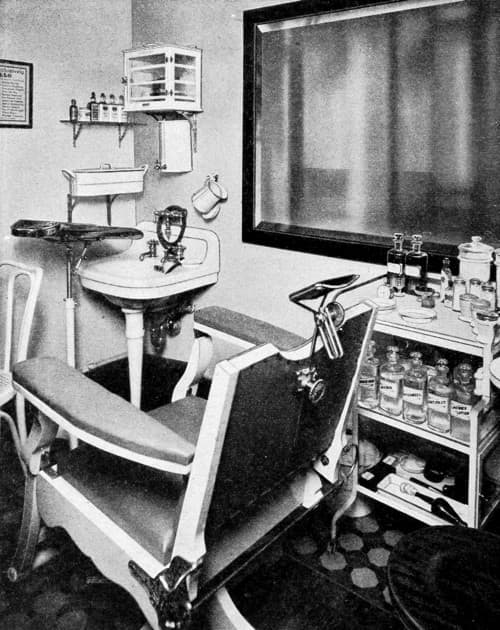
Above: 1914 Marinello shampoo and facial booth.
Marinello salon treatments used anything that was believed to be effective. For example, while some salon chains had arguments over whether facial massage or patting was best practice, Marinello salons used both. In fact, I have yet to find a treatment type used in any beauty salon up to 1927 – the year that Maurer lost control of the company – that could not also be found in the Marinello treatment book.
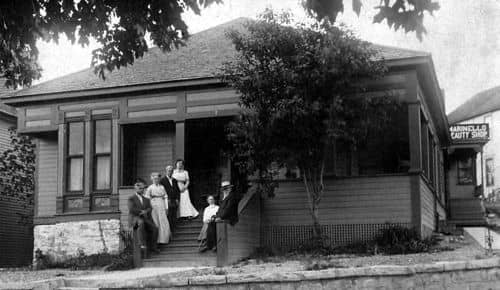
Above: House in Chicago with a Marinello Beauty Shop on the side.
Another feature of Marinello of treatments was the widespread use of machine aids and electricity. This may have stemmed from the fact that Maurer’s original book was written in conjunction with the McIntosh Battery and Optical Company but it may also reflect an American sensibility. Moler, for example, also included hydro-vacu treatments, electrical facial massage, electrical roller treatments, vibratory facial massage and electrolysis in his barber training manual (Moler, 1905).
Examples of Marinello skin treatments that date from around 1920 include:
Plain Facial: “Her patrons leave, looking and feeling years younger as well as strangely rested, at peace with themselves and the rest of the world, and anxious to return to the same operator for the same type of treatment.” Preparations: Lettuce Cream, Whitening Cream, Acne Cream, Tissue Cream, Motor Cream, Astringent Cream, Lavender Lotion, Skin Toning Lotion combined with Iontophoreis.
Rest Facial: “A Scientific Massage Treatment in which the patron is rested, refreshed and decidedly benefited. Especially good for nervous, tired, and prematurely withered or aged skins, as well as for general use.” Preparations: Lettuce Cream, Lavender Lotion, Combination Cream, Skin Toning Lotion combined with Iontophoresis.
Muscle Strapping: “[I]s given to tone, lift and develop the muscles. It is possible to remove all lines with this treatment providing the patron will co-operate and have as many treatments a week as operator may see fit to produce results. Patron should also he advised to use Muscle Strapping Outfit at home which sells for US$15.00 and contains every thing necessary for home treatment.” Preparations: Lettuce Cream, Muscle Oil, Tissue Cream, Witch Hazel, Lavender Lotion combined with Iontophoresis and High Frequency.
Tired Eye Massage: “The use of the eye cup and finger manipulation in conjunction with the bandalette for tired or inflamed eyes brings great relief.” Preparations: Lettuce Cream, Witch Hazel, Muscle Oil, Lavender Lotion, Skin Toning Lotion combined with Eye Cup, Bandalette and Iontophoresis.
Coarse Pore Astringent Treatment: “Frequently the afflictions that cause the most grief are apparently of such innocent origin that little is done to relieve them and as a consequence women suffer for years from oily skins, feeling that nothing can be done to cure this trouble.“ Preparations: Lettuce Cream, Astringent Cream, Whitening Cream, Astringent Lotion, Witch Hazel combined with Electrolytic Cup, Faradic Muscle Contraction and Patters.
Dry Skin Astringent Treatment: “Complexions of this description need constant care to keep them in good condition, and women who are so afflicted should make up their minds to submit cheerfully to the inevitable in the shape of constant and frequent applications of oils and skin foods in order to keep the skin smooth.” Preparations: Lettuce Cream, Muscle Oil, Tissue Cream, Astringent Lotion, Foundation Cream combined with Electrolytic Cup, High Frequency, Light Treatment, Iontophoresis and Patters.
Acne Treatment: “In all Acne cases the good results of the treatments depend upon the care with which the comedones are removed. The work is tedious,but necessary and while the skin should not be bruised by undue pressure, still, unless the pests are removed there will be no improvement – hence the necessity for care and attention.” Preparations: Medicated Soap, Acne Lotion, Acne Cream, Medicated Powder, Stronger Acne Cream combined with High Frequency.
Methine Treatment: For Acne Rosacea. “In this condition nose, chin and cheeks are often times very red and angry looking and covered with small red papules. When the condition has become chronic the superficial blood vessels wilt be much dilated.” Preparations: Medicated Soap, Lettuce Cream, Methine Tincture, Methine Ointment, Stronger Acne Cream, Astringent Cream, Lavender Lotion, Calmine Lotion, Medicated Powder combined with Iontophoresis and Light Treatment.
Bleach Mask: For Tan, Freckles, Leukoderma, Chloasma, Oily Skin with large pores, and Acne. “This process will positively bleach the skin from two to five shades without irritation, if care is used in giving the treatment. Occasionally, in very sensitive subjects, a rash will appear the following day, but this soon vanishes, and the skin will be clearer than before.” Preparations: Lettuce Cream, Bleaching Lotion, Witch Hazel, Tissue Cream, Whitening Cream, Lavender Lotion, Refining Powder combined with Iontophoresis and Light Treatment.
Milk Beaching treatment: “This treatment is intended for skins too sensitive to stand the other bleaching treatment. It has a refining, softening influence on the skin leaving it as soft as velvet, and can be used on practically every condition.” Preparations: Lettuce Cream, combination Cream, Boracic Acid Solution, Witch Hazel, Milk, Astringent powder, Muscle Oil, Skin Toning Lotion. Treatment may also use Iontophoresis and Light Treatment.
Marinello Wrinkle Mask: “Given for deep and superficial lines. Action lifts tissues underneath lines filling up epithelium.” Preparations: Lettuce Cream, Whitening Cream,Tissue Cream, Combination Cream, Astringent Lotion, Wrinkle Paste, Motor Cream, Foundation Cream, Witch Hazel, Bi-carbonate of Soda combined with Faradic Muscle Contraction, and Iontophoresis.
See also: Iontophoresis, High Frequency, Electrolytic Cup and Red Light, Blue Light
A move east
In the 1920s, the Marinello began to move its base of operations to New York, by then a major centre for Beauty Culture. The company opened an ‘Eastern Office’ at 366 Fifth Avenue, New York while the ’Western Office ’ in Chicago moved to the Mallers Building. In 1925, the company headquarters were moved to 72 Fifth Avenue, New York and manufacturing operations began in New York City. The seven-storey building included offices, a Marinello school and manufacturing facilities.

Above: 1925 The seven-storey Marinello building at 72 Fifth Avenue, New York. First floor: Retail and wholesale display; Second floor: Post-graduate training; Third floor: Marinello school; Fourth floor: Executive offices; Fifth, sixth and seventh floors: Manufacturing.
The year 1925 marked the high point for the company with Marinello schools functioning in New York, Philadelphia, Chicago, Cincinnati, Minneapolis, Detroit, St Louis, Denver, Los Angeles and Portland Oregon; somewhere between 25,000 and 30,000 Marinello beauticians operating across the United States; and over 8000 beauty shops using Marinello products, with about 6000 of these using Marinello products exclusively (AP&EOR, 1925). Unfortunately for Maurer, things would go badly for her when Inecto took control of her business in 1927.
Inecto
Inecto, Inc. was established by the advertising executive, Neal R. Andrews [1891-1953], in 1919 to bring the French hair dye, Inecto Rapid, to the United States. Ralph L. Evans [1895-1965] joined the firm in 1923 as its chemist but soon became a stockholder and took a management position.
The company had a number of links with Marinello. Inecto products, such as Inecto Rapid Notox, were used in Marinello salons and both companies used the same sales company, F. Richie & Co., to distribute their goods. In 1927, Inecto negotiated a deal with Marinello that saw them gain management responsibility for both Marinello Products and the National School of Cosmeticians. Why Ruth Maurer agreed to this arrangement is unknown to me but Chilson suggests that money problems were part of the reason.
She [Ruth D. Maurer] was continually surrounded by a noisome collection of sycophants who bled her dry of money and eventually forced her to sell out to the Inecto Company, then the largest hair dye company in this country.
(Chilson, 1972, p. 60)
Maurer’s relationship with Andrews and Evans quickly deteriorated, leading to her resigning from Marinello in 1929 after a US$30,000 buyout (Peterson, 2004). She also quit the National School of Cosmeticians.
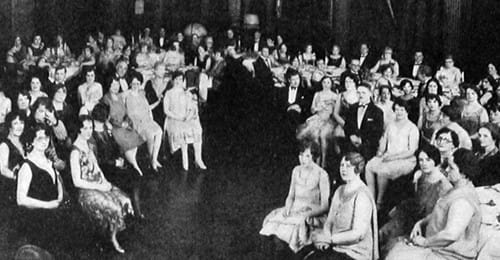
Above: Part of the group photograph taken at the Marinello Winter School in 1928. The unhappy looking woman on the bottom right with her back almost to us appears to be Ruth Maurer. One of the causes of her distress, Neal Andrews, attended the conference and may also be in the photograph.
Despite claims that she was retiring, Ruth Maurer quickly established the Ruth D. Maurer Corporation later in 1929 and then began producing a new line of cosmetics under the Rudemar brand in 1930.
See also: Rudemar
Reorganisation
After Maurer left, Neal Andrews and Ralph Evans set about reorganising the various Marinello businesses. In 1929, they replaced F. Richie & Co. with their own sales force of 12 people organised into a newly established business, Sales Affiliates, Inc. The following year they founded Andrevan, Inc. in New York, the name formed from an amalgamation of their surnames, which they wholly owned. They then used that company to acquired the stock of the other three corporations; Sales Affiliates, Inc., Inecto, Inc., and the Marinello Company.
In 1932, Andrevan changed its businesses procedures after the Revenue Act (1932) raised the U.S. corporate tax rate by almost 15 per cent. Inecto and Marinello began selling their products directly to Sales Affiliates, Inc., at a new low price which Sales Affiliates then sold it to the trade at the old higher price. This was done to reduce the tax the company paid, a strategy that failed after the American Internal Revenue Service (IRS) won its case against Bourjois who had done something similar.
See also: Bourjois (post 1930)
Relationships between the various businesses were altered again in 1933 with Inecto becoming responsible for all manufacturing, while Marinello was reduced to a bottling and packaging operation. However, as all the businesses now operated out of the same New York building at 33 West 46th Street – incidentally owned by the Notox Realty Corporation, another wholly owned subsidiary of Andrevan – operations were largely unaffected by the paper shuffling.
The Marinello schools continued. The organisation of the textbook and curriculum was passed to Florence E. Wall [1893-1988] an Inecto employee who had been working as a technical advisor before developing Inecto’s training school – the Notox Institute of Canities – and the accompanying textbook – ‘Canitics. The treatment of canities reduced to a science and elevated to an art’ – in 1926. Although Wall left in 1928 she helped write a range of new Marinello courses introduced in that year and was largely responsible for the production of the first edition of ‘The Science of Beautistry’, the new textbook for the National School of Cosmeticians, even though it was not published until 1932. Wall retained her interest in Beauty Culture after she left Marinello and went on to become a leading educator in the field with a number of books to her credit.
Other positive developments followed. The new owners repackaged the line in 1929, using attractive soft-pink glass jars topped with silver lids, with an Art Deco looking head in profile on the label, a considerable improvement over the older Art Nouveau inspired packaging which was looking dated. The Marinello line was also introduced into Europe but the agencies there do not appear to have survived the Second World War.
Zotos
Sales Affiliates continued to promote Marinello products but interest in the cosmetics side of their operation declined as the hair-care side of the business became more profitable. The introduction of Zotos machineless permanent waving pads in 1932 created a good deal of salon business during the depression years. They must have been the saviour of many small town salons in the depression when customers could get cosmetics through cut-price stores and follow their own skin-care regimes at home. Salon operators could charge US$15 dollars for a permanent wave, a considerable sum of money for the time. Demand for Zotos salon permanents remained high following the development of thioglycolic acid cold waves in 1939, for which Sales Affiliates held patents, only becoming threatened by the introduction of Toni home permanents and similar products after the Second World War.
Although the Marinello products continued to be supported – with the line being rebranded after the Second World War – use of its products declined and the brand eventually disappeared, a fate shared by a number of other cosmetic companies as well. However, not all traces of Marinello disappeared. The Marinello Schools remained in operation in the United States until 2016 and Zotos, Inc., the successor to Sales Affiliates, continues as a part of Shiseido Co., Ltd.
Timeline
| 1903 | First edition of ‘The Skin: Its Care and Treatment’ published. |
| 1903 | The Marinello Company formed. |
| 1905 | Marinello Training School founded. |
| 1912 | Marinello factory moves to 209 Fifth Avenue South, La Cross, Wisconsin. |
| 1915 | First edition of ‘The Marinello Text Book: Teaching the Care of the Face, Scalp, Hair and Hands’ published. |
| 1918 | Marinello charged under the Clayton Anti-trust Act. |
| 1919 | Marinello factory moves to 225 South Sixth Street, La Cross, Wisconsin. |
| n.d. | Marinello Eastern Office opens at 366 Fifth Avenue New York. Western Office moves to Mallers Building, Chicago. |
| 1925 | Marinello headquarters moved to 72 Fifth Avenue New York and begins manufacturing operations in NYC. |
| 1927 | Inecto, Inc. acquires the Marinello Company and the National School of Cosmeticians. |
| 1928 | Marinello starts a new operators course, a Marcel finishing course and 15 special subject courses. |
| 1929 | Sales Affiliates, Inc. established to sell the products of Marinello and Inecto, Inc. They were previously selling their products through F. Richie & Co. Ruth D. Maurer resigns from Marinello. |
| 1930 | Andrevan, Inc. owned by Neal R. Andrews and Ralph L. Evans, acquires the stock of Sales Affiliates, Inc., Inecto, Inc., and the Marinello Company. |
| 1931 | Marinello Products established in France. |
| 1932 | A new method of operation was adopted. Inecto, Inc., and Marinello Company sold their entire output to Sales Affiliates, Inc. First edition of ‘The Science of Beautistry’ published. |
| 1933 | Inecto acquires all the manufacturing equipment and business of Marinello, and Marinello acquired all the packaging business of Inecto. Marinello became a bottling and packaging company only. Factories of Marinello and its affiliates Inecto and Zotos Corporation move to Hoboken N.J. Executive offices and laboratory transferred to 33 West 46th Street where the offices of Inecto and Zotos have been for some time. |
| 1938 | Royal Academy of Cosmeticians begins teaching the Marinello System. |
| 1944 | Marinello line repackaged in aqua with a pink satin bow. |
| 1963 | Marinello Schools purchased by Scope Industries with headquarters located in Los Angeles. |
| 1982 | Zotos bought by Conair Corporation from R. L. Evans, Jr. |
| 1988 | Zotos International purchased by Shiseido Co. Ltd from Conair Corporation. |
| 2004 | Marinello Schools are under the ownership of B&H Education, Inc. located in Beverly Hills, CA. |
| 2016 | Marinello Schools closed. |
First Posted: 19th December 2013
Last Update: 12th December 2024
Sources
The American perfumer & essential oil review. (1925-29). New York: Robbins Perfumer Co.
Chilson, F. (1972). Some historic personalities of the cosmetic industry. American Cosmetics and Perfumery. 87, 59-61.
La Crosse Grand Excursion Educate Committee. (2004). Where rivers meet: An educator’s guide to the history of La Crosse, Wisconsin. Retrieved December 1, 2013, from http://lacrosselibrary.org/digital/grandexcursion/contents.htm
Lloyd, E. (1904). The skin. Its care and treatment (2nd ed.). Chicago: McIntosh Battery and Optical Company.
Lloyd, E. (1907). The skin. Its care and treatment (3rd ed.). Chicago: McIntosh Battery and Optical Company.
Lloyd, E. (1910). The skin. Its care and treatment (4th ed.). Chicago: McIntosh Battery and Optical Company.
Lloyd, E. (1914). The skin. Its care and treatment (5th ed.). Chicago: McIntosh Battery and Optical Company.
Lloyd, E. (1910). The prismatic ray in the treatment of face and scalp. Chicago: New Medicine Publishing Company.
Lloyd, E. (1920). Special lessons. Chicago: Marinello Company.
Marinello – Part 1 – Pachyderms and Pseudonyms. (2012, April 4). Retrieved December 1, 2013, from http://collectingvintagecompacts.blogspot.com.au/2012/04/marinello-pachyderms-and-pseudonyms.html
Marinello – Part 2 – The Uncrowned Cosmetics Goddess. (2012, August 23). Retrieved December 1, 2013, from http://collectingvintagecompacts.blogspot.com.au/2012/08/marinello-part-2-uncrowned-cosmetics.html
McIntosh Battery and Optical Company. (1903). The skin. Its care and treatment. Chicago: Author.
Meyers, H. J. (1909). American College and Private School Directory. Chicago: Educational Aid Society.
Moler, A.B. (1905). The manual on barbering, hairdressing, manicuring, facial massage, electrolysis and chiropody as taught in the Moler system of colleges.
Paschkis, H. (1890). Cosmetics; a treatment for physicians. Wood’s Medical and Surgical Monographs, 8(2), 271-472.
Wall, F. E. (1926). Canitics. The treatment of canities reduced to a science and elevated to an art. New York: Beautician Publications.
Wynne, J. R., & Levinger, I. D. (1995). The NCA’s diamond jubilee years. Korea: National Cosmetology Association.
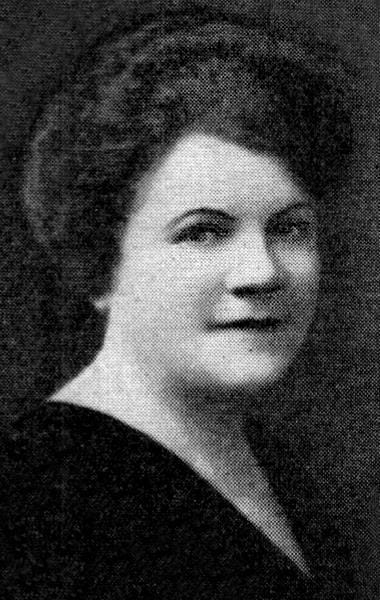
Ruth D. Maurer [1871-1945] a.k.a. Ruth Johnson, Ruth D. Johnson Maurer, Emily Lloyd and Mme. Michaud. Described unflatteringly by Francis Chilson as “short, fat and autocratic”.
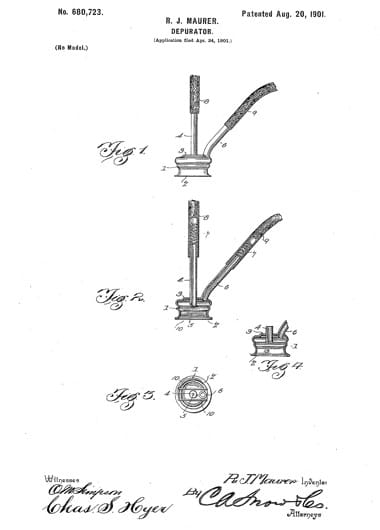
1901 Depurator patent. Depurators function by creating a partial vacuum which helps remove detritus and other material from a wound. Although they are still in use today they were even more important in the days before the invention of antimicrobial drugs and antibiotics. Some included an inlet tube which allowed medication to be applied to the wound while it was being cleaned; this is the type that Maurer patented.
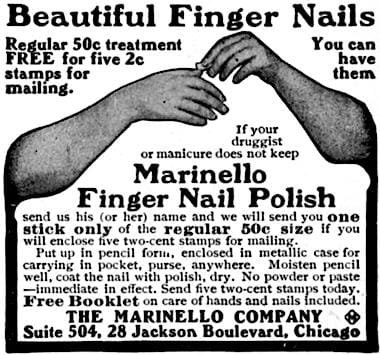
1903 Marinello Finger Nail Polish.

1903 Marinello product list with an image of Ruth Maurer wearing historical costume from ‘The Skin. Its Care and Treatment’ (1903). Both Marinello companies are mentioned.
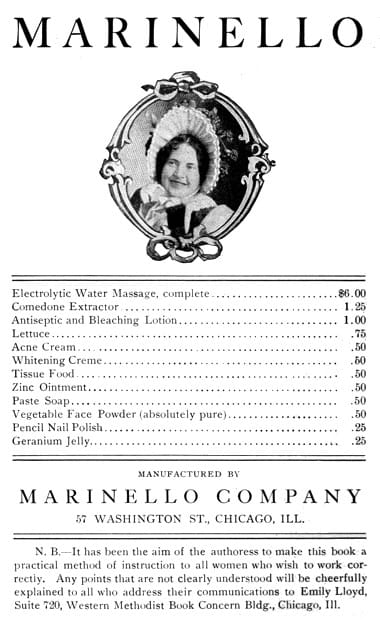
1904 Marinello product list from ‘The Skin. Its Care and Treatment’ (1904). Note the reference to contacting Emily Lloyd. The 1903 text stated: “It has been the aim of the author to make this book a practical method of instruction for all women who wish to work correctly. Any points that are not clearly understood will be cheerfully explained to all who address their communications to the McIntosh Battery and Optical Co., 39 W. Randolph Street, Chicago, 111.”
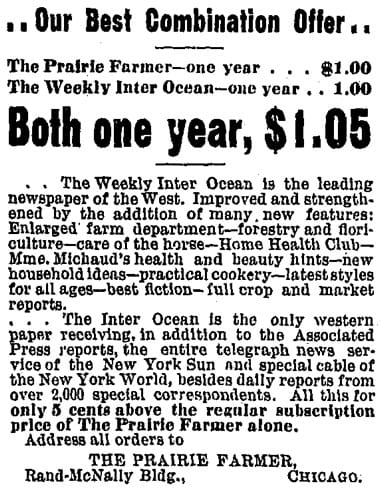
1905 Advertisement for ‘Weekly Inter Ocean’ with a reference to Mme. Michaud’s health and beauty hints.
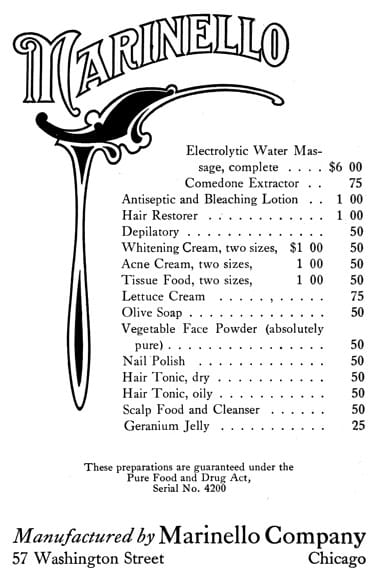
1907 Marinello Company (Chicago) product list from ‘The Skin. Its Care and Treatment’ (1907).
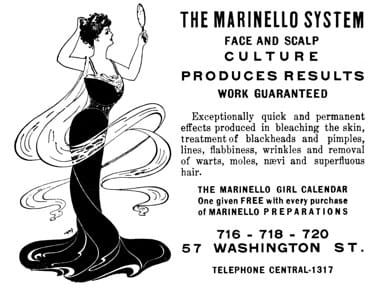
1907 The Marinello System.
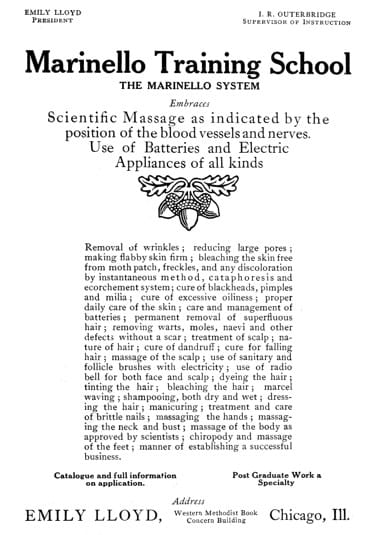
1907 Marinello School advertisement with a detailed list of the course areas from ‘The Skin. Its Care and Treatment’ (1907).
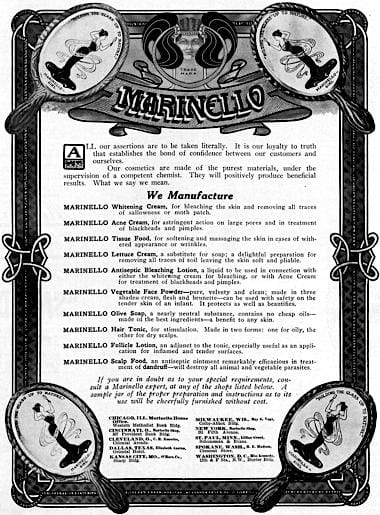
1909 Marinello.
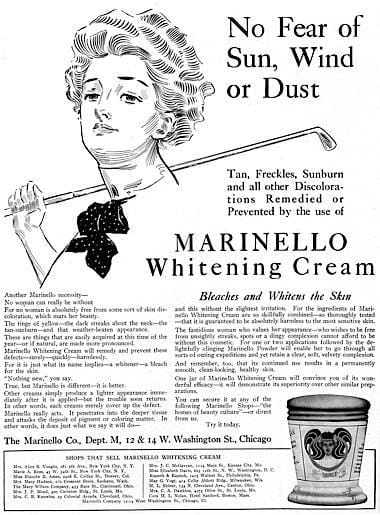
1911 Marinello Whitening Cream.
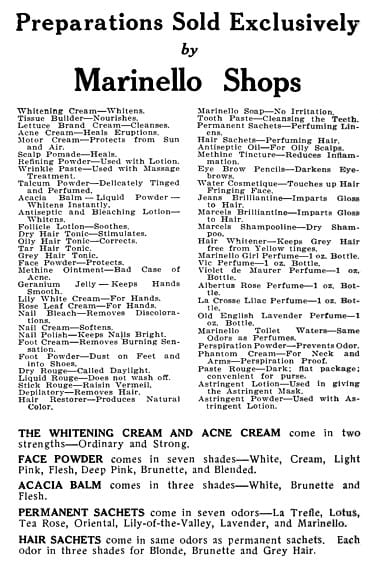
1914 Marinello product list sold exclusively through Marinello Shops from ‘The Skin. Its Care and Treatment’ (1914).
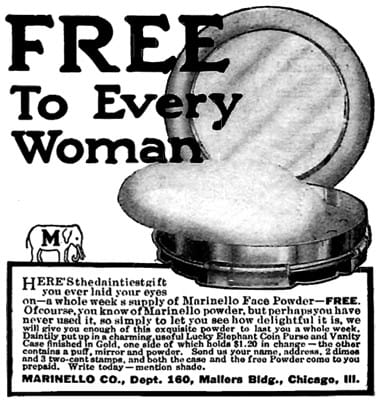
1914 Marinello powder promotion coin purse.
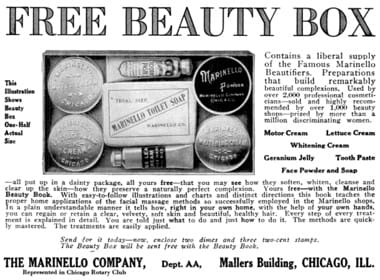
1914 Marinello Beauty Box. This free sample box contained samples of Motor Cream, Lettuce Cream, Whitening Cream, Geranium Jelly, Face Powder and Soap along with a company brochure.
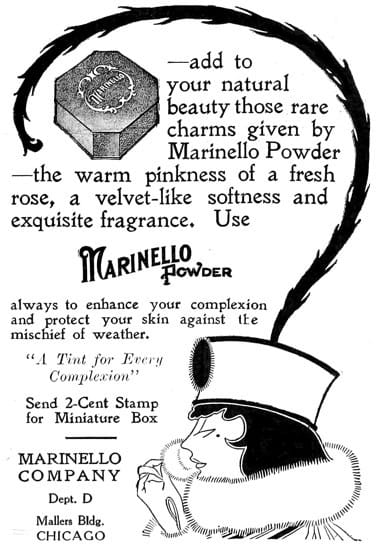
1916 Marinello Face Powder.

1916 Marinello Powder.

1917 Marinello Toilet Preparations.
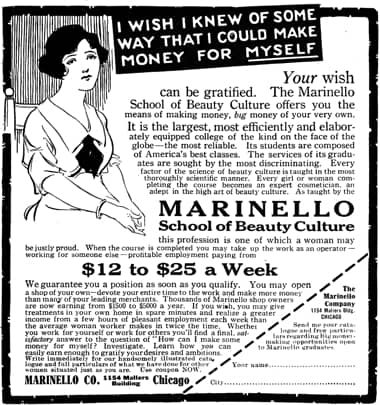
1917 Marinello School of Beauty Culture.
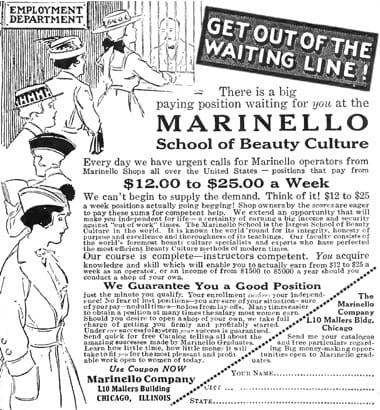
1917 Marinello School of Beauty Culture.
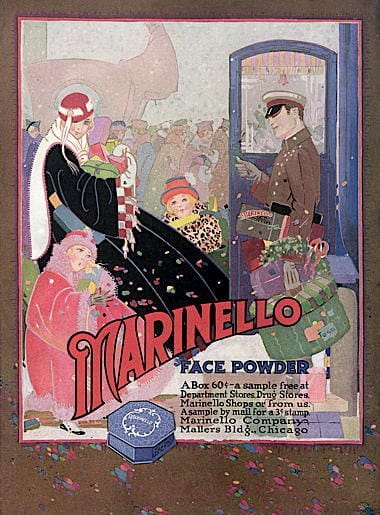
1918 Marinello Face Powder.
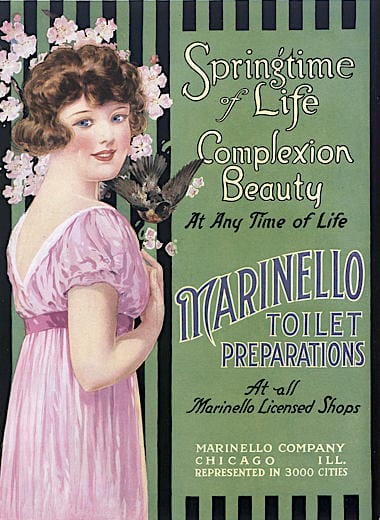
1918 Marinello Toilet Preparations.
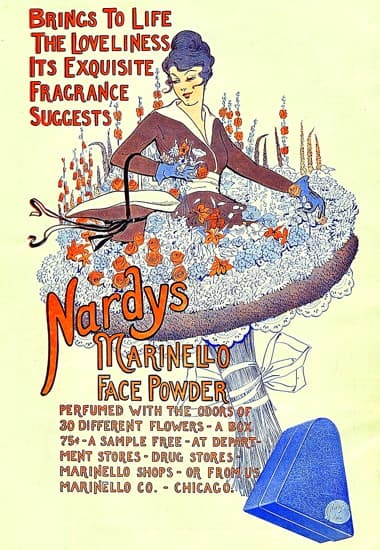
1918 Marinello Nardys Face Powder.
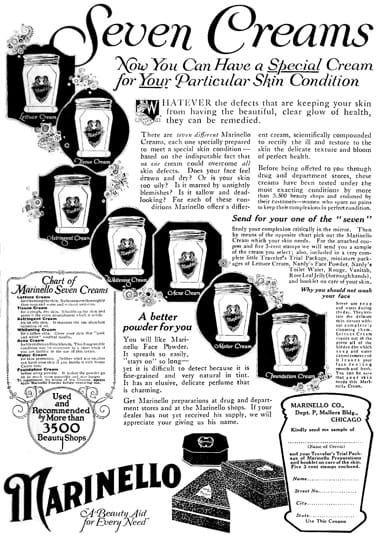
1919 Marinello Seven Creams.
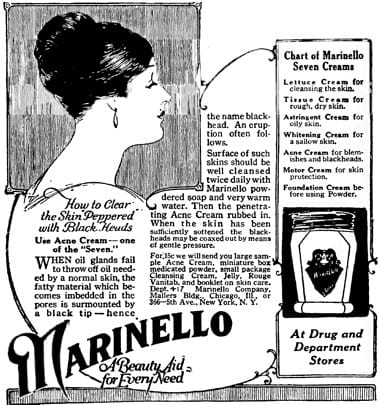
1919 Marinello Creams.
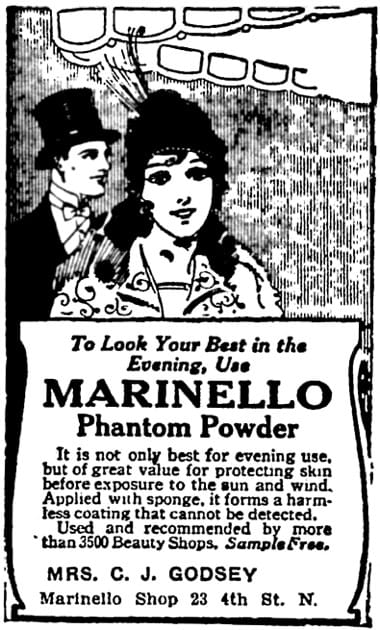
1919 Marinello Phantom Powder. Advertising by local salons helped sell Marinello products while keeping the advertising costs of the company down. Many of these advertised goods were only available through Marinello salons
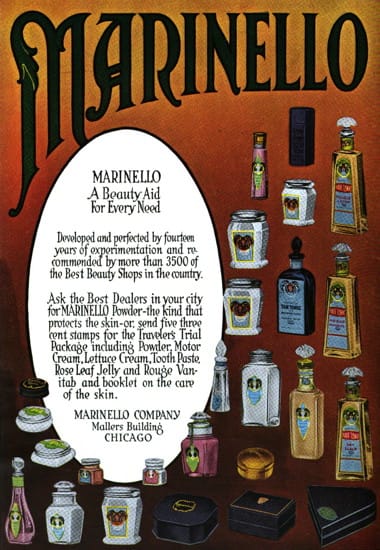
1919 Marinello beauty products. Like many other American cosmetic companies packaging remained largely nineteenth century in taste until the 1930s when many repackaged in an attempt to improve sales during the depression. Marinello packaging through to 1929 was rather dull and only relieved by the inclusion in the label of an Art Nouveaux inspired woman’s head. Maurer had a penchant for elephants and these were also used as a decorative elements in company advertising, a practice that could still be seen occasionally in the 1930s.
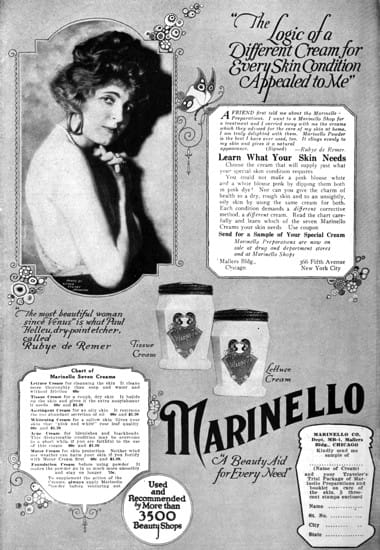
1919 Marinello beauty creams.
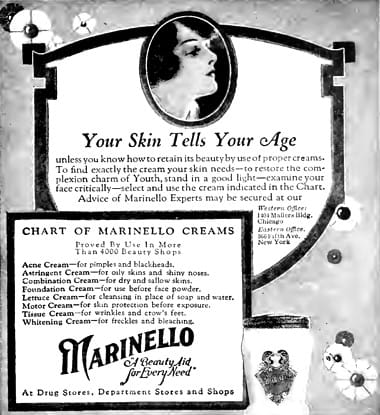
1920 Marinello.

1920 Marinello.
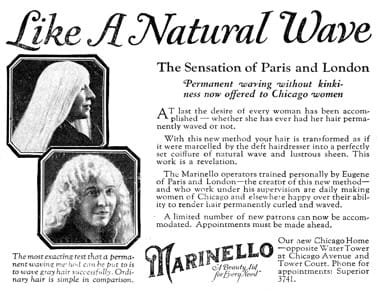
1923 Marinello and Eugene permenant waving.
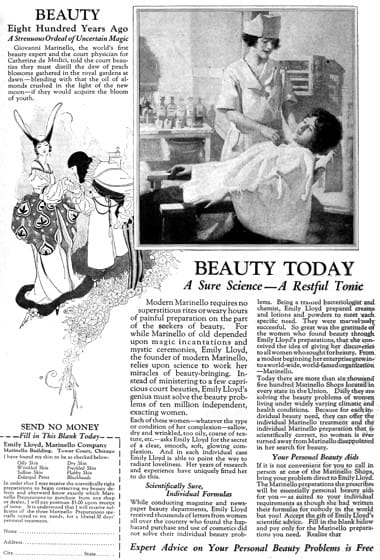
1923 Marinello beauty treatments.
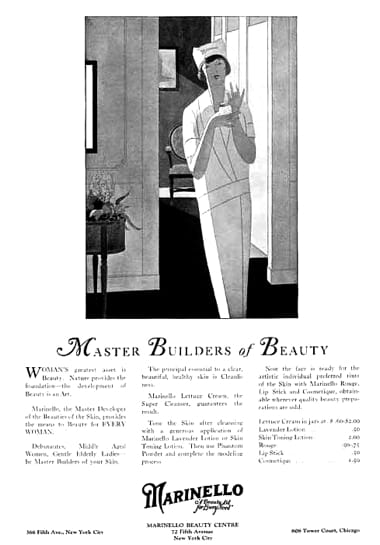
1925 Marinello Beauty Culture.
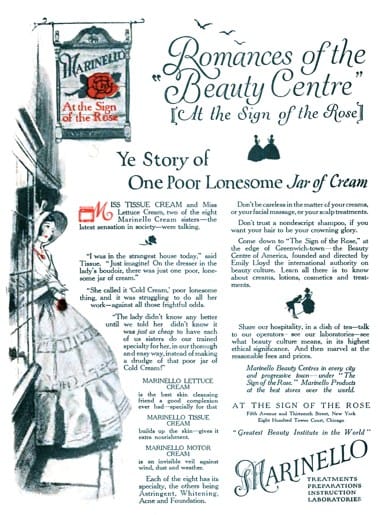
1925 Marinello Beauty Centre. The use of a rose logo does not seem to have been followed up.
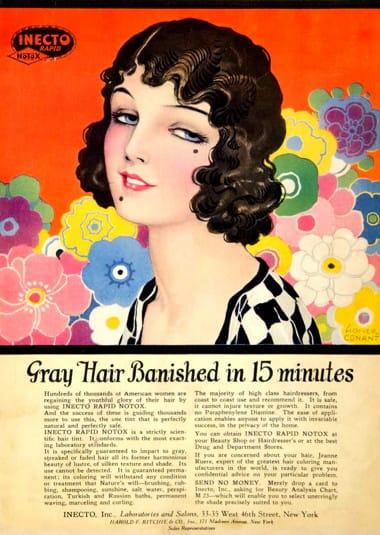
1925 Inecto.
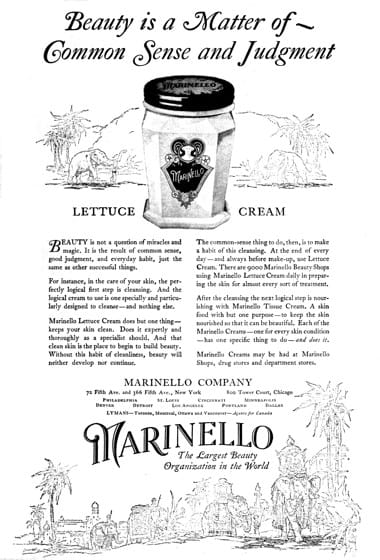
1926 Marinello Lettuce Cream.

1927 Marinello Products (London).
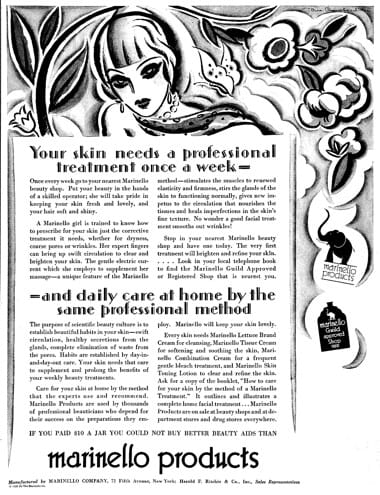
1928 Marinello.
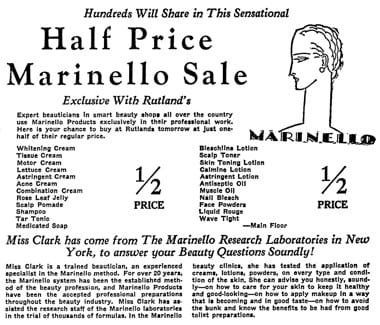
1929 Marinello. The new owners removed the Marinello salon exclusivity and put most of the Marinello line up for general sale.
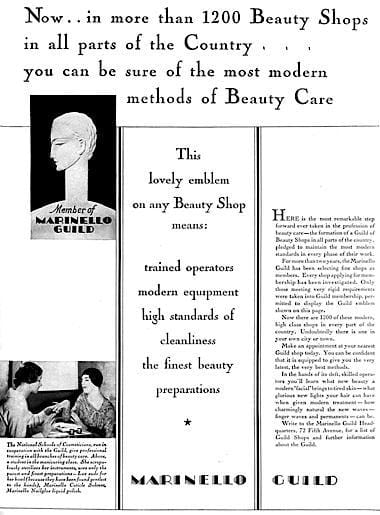
1929 Marinello Guild.
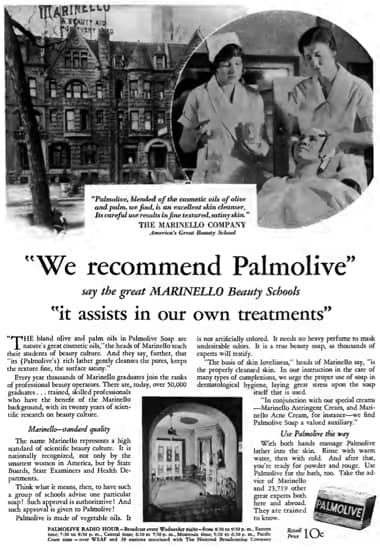
1930 Marinello endorsement for Palmolive Soap.
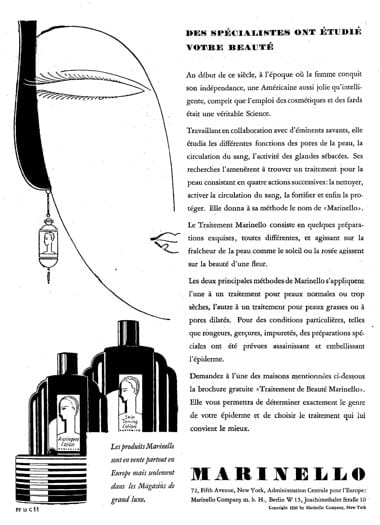
1931 Marinello with product drawings showing the new logo and bottle designs.
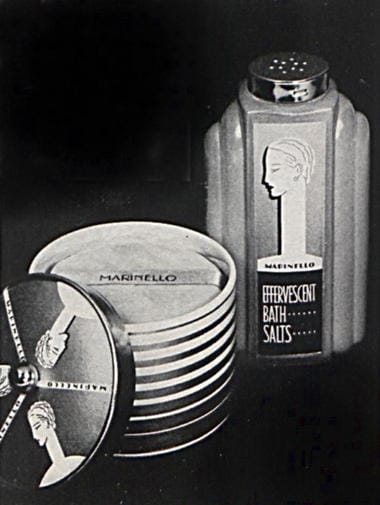
1931 Marinello Powder and Bath Salts.
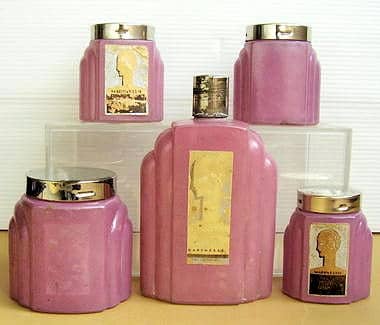
Assorted Marinello products in new logo and bottle designs.
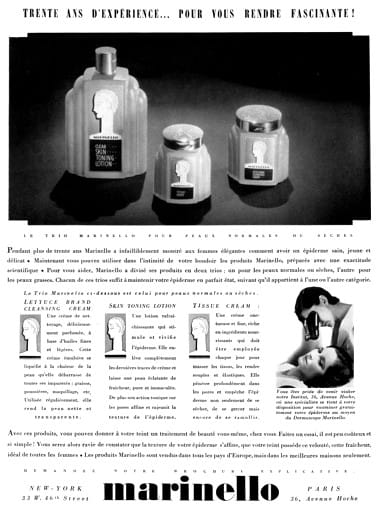
1934 Marinello at 36, Avenue Hoche, Paris. As well as the updated logo and bottle designs, the advertisement shows a Dermateuse using a Marinello Dermascope to more closely examine a client’s skin. Marinello had trademarked the device in 1931.
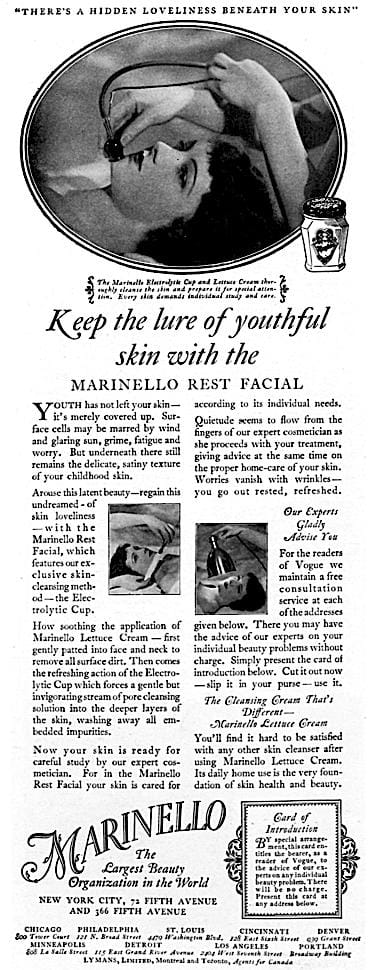
1936 Marinello Rest Facial.
